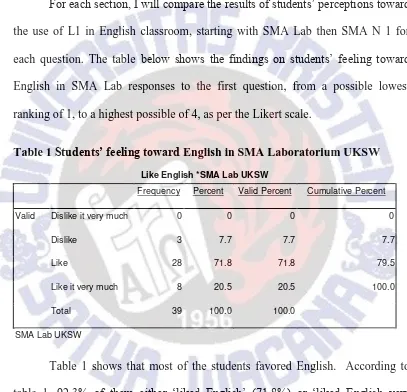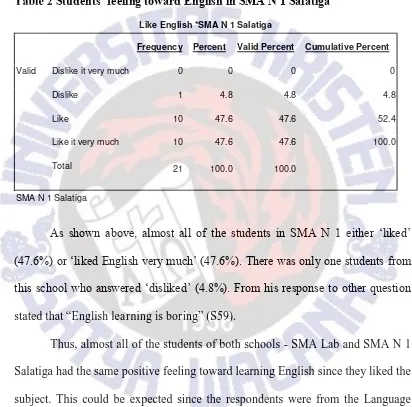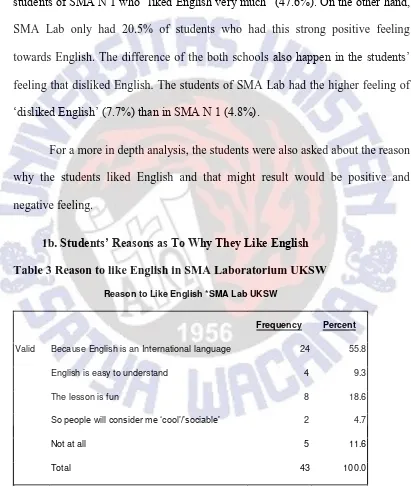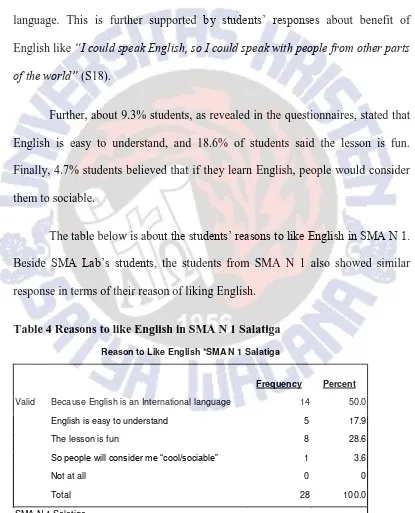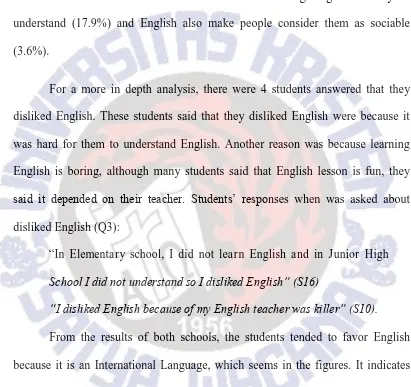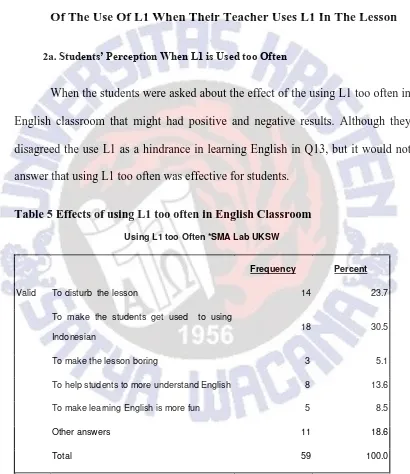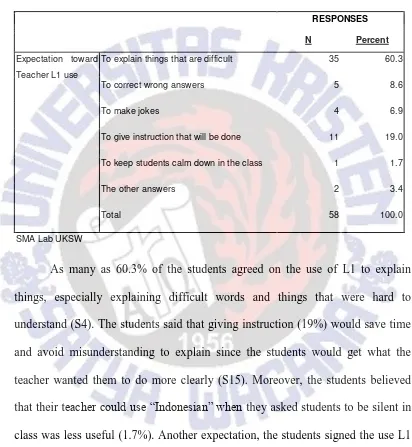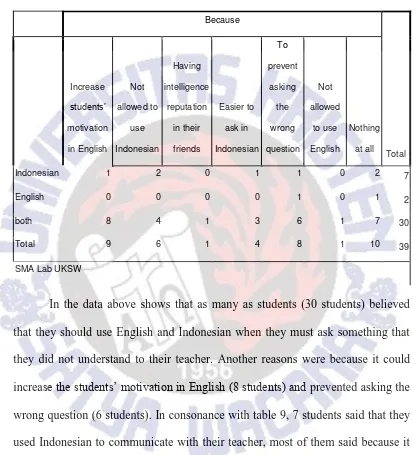STUDENTS’ PERCEPTIONS TOWARD
THE USE OF L1
(INDONESIAN) IN ENGLISH CLASSROOM
THESIS
Submitted in Partial Fulfillment of the Requirements for the Degree of
Sarjana Pendidikan
Ludvi Ainun Septeria
112010114
ENGLISH LANGUAGE EDUCATION PROGRAM
FACULTY OF LANGUAGE AND LITERATURE
SATYA WACANA CHRISTIAN UNIVERSITY
SALATIGA
i
STUDENTS’ PERCEPTIONS TOWARD
THE USE OF L1
(INDONESIAN) IN ENGLISH CLASSROOM
THESIS
Submitted in Partial Fulfillment of the Requirements for the Degree of
Sarjana Pendidikan
Ludvi Ainun Septeria
112010114
ENGLISH LANGUAGE EDUCATION PROGRAM
FACULTY OF LANGUAGE AND LITERATURE
SATYA WACANA CHRISTIAN UNIVERSITY
SALATIGA
iii
COPYRIGHT STATEMENT
This thesis contains no such material as has been submitted for examination in any course or accepted for the fulfillment of any degree or diploma in any university. To the best my knowledge and my belief, this contains no material previously published or written by any other person expect where due references is made in the text.
Copyright@2015. Ludvi Ainun Septeria and Elisabet Titik Murtisari, M. TransStud.,Ph.D
All right reserved. No part of this thesis may be produced by any means without permission of at least one of the copyright owner or the English Department, Faculty of Language and Literature, Satya Wacana Christian University, Salatiga
vi
TABLE OF CONTENTS
INSIDE COVER PAGE ... i
APPROVAL PAGE ... ii
COPYRIGHT STATEMENT ... iii
PUBLICATION AGREEMENT DECLARATION ... iv
PLAGIARISM STATEMENT……….v
TABLE OF CONTENTS ... vi
LIST OF TABLES ... viii
ABSTRACT ... 1
A. INTRODUCTION ... 1
1. Historical view of the issue ... 4
2. Advantages and disadvantages of using L1 in the classroom ... 5
2a. Advantages of using L1 in the classroom ... 5
2b. Disadvantages of using L1 in the classroom ... 6
B. THE STUDY ... 8
1. Context of the study ... 8
2. Participants ... 9
3. Instrument of data collection... 9
4. Data Collection Procedure ... 10
5. Data Analysis ... 11
C. DISCUSSIONS ... 11
1. Students‟ Feelings toward the English Lesson and Their Reasons Why They Feel Like English Lesson ... 12
vii
1b. Students‟ Reasons as To Why They Like English ... 14
2. Students‟ Perceptions Toward The Frequent That Happen Often Of The Use Of L1 When Their Teacher Uses L1 In The Lesson ... 17
2a. Students‟ Perception When L1 is Used too Often ... 17
2b. Students‟ Expectation toward the Use of L1... 20
3. Students‟ Language Preference When Communicating With Their Teacher In English Classroom ... 22
3a. Students‟ Reasons for Using English, L1 or Both Languages When Communicating With Their Teacher ... 22
D. CONCLUSION ... 26
ACKNOWLEDGEMENT ... 29
REFERENCES ... 30
viii
LIST OF TABLES
Table 1 Students‟ feeling toward English in SMA Laboratorium UKSW ... 12
Table 2 Students‟ feeling toward English in SMA N 1 Salatiga ... 13
Table 3 Reason to like English in SMA Laboratorium UKSW ... 14
Table 4 Reasons to like English in SMA N 1 Salatiga ... 15
Table 5 Effects of using L1 too often in English Classroom ... 17
Table 6 Effects of using L1 too often in English Classroom ... 18
Table 7 Multiple responses toward what the students expect the teacher use L1 for ... 20
Table 8 Multiple responses toward what the students expect the teacher use L1 for ... 21
1
STUDENTS’ PERCEPTIONS TOWARD THE USE
OF L1
(INDONESIAN) IN ENGLISH CLASSROOM
Ludvi Ainun Septeria
ABSTRACT
The use of L1 in teaching a foreign language became a controversial issue. Nowadays, many teachers confused to use the language when they taught their students. It is because the students often get hard to understand the materials. This study examined the perceptions of students toward the use of L1 (Indonesian) in English classroom at SMA Laboratorium UKSW and SMA N 1 Salatiga. The research was focused on Language Stream which had 60 students from both schools. The data is collected from the questionnaires that were given to the XI and XII year students which would be analyzed using SPSS software. One of the findings shows that the students actually perceived L1 as a tool to help them study English better, especially when they would have to ask their teachers something they do not understand. However, the result also shows that if L1 is used too much, the students would then perceive it would not be effective for students; they thought that it makes the students get used to using Indonesian and disturbs the English learning. Another finding revealed that the students liked their teacher to use L1 when the teacher explains things that are difficult.
Keywords: students‟ perception, L1 (Indonesian), L2 (English), use of L1.
A.
INTRODUCTION
Nowadays, there are many issues one the use of L1 in EFL classroom.
English is believed as the key to survive and succeed in the coming era. However,
most people have realized that learning English is not an easy matter. English is
an important tool for communication which is used to interact with others who
have different first languages. Therefore, there is no doubt that English is an
international language because many people all over the world speak English,
2
were two research findings that resulted in two opposing views. According to
Qadri, the first finding is Polio & Duff (1994) supported the use of English and
prohibits the use of L1 when teaching the students. The second finding,
Rinvolucri & Turnbull (2002) supported and allowed the use of L1 in the English
teaching classroom (as cited in Qadri, 2006). This might also divide the teachers‟
perception into two different points. If they would use only English in the
classroom, then they would perceive L1 as a negative aspect in their teaching and
avoid the use of L1. As the opposite, the teachers who support the use of L1
would perceive it as positive aspect in their teaching, meaning they would use L1
to facilitate the teaching and learning process.
Even though it might be true that by using only English in class the
students would get more exposure to the language and they would be able to
become more familiar with the language faster, if the English proficiency of the
students is not high enough they would not be able to understand what the
teachers explain to them. Just as the teachers have their perceptions toward using
L1, the students also have their own perception toward the use of L1 in their
English learning process. According to Qadri (2006) supported the students
would be more exposure to their L1 compared to English since the most exposure
to English they might get was from the English school teachers.
Based on my own experience in High School, most English teachers could
not avoid using Indonesian when teaching English. They also often used
Indonesian in the classroom when they taught English. This condition may happen
3
which use Indonesian to communicate daily. Secondly, Indonesian students are
mostly taught by non-native teachers that unconsciously make students tend to
speak in their first language (Indonesian) even in the English classes. Some
experts like Long (1984), Charles (1987), and Ellis (1986), considered L1 is still
used in English teaching because there is no rule that forbid the use of L1 in
English classes. On the other hand, Krashen (1985) and Phillipson (1992) pointed
out that English teaching should use English as much as possible to facilitate
students their learning in the classroom. This study was aimed to investigate on
students‟ perceptions toward the use of L1 (Indonesian) in English Classroom. By
doing this study, I hope that English teachers might understand better what their
students actually expected from them.
This study aims to answer the following research question, “What are the students‟ perceptions toward the use of L1 (Indonesian) in English classroom to SMA students?”
Sub questions:
1. What are the students‟ feelings toward the English lesson and their reasons
as to why they feel like that?
2. How are the students‟ perceptions toward the frequent that happen often of
the use of L1 when their teacher uses L1 in the lesson?
3. What is the students‟ language preference when communicating with their
teacher in class?
This study would be useful for English Education Program students to
have better understanding on how their first language can influence the new
4
can bring positive and negative effect on the students. Besides, the writer hopes
that this study can help the teachers and students to adjust one to another so that
the purpose of the English teaching can be achieved together. The teachers can
manage the use of L1 in their teaching quality. The writer also hopes that this
study can also be a good inspiration to them to design an effective English
teaching-learning strategy.
1. Historical view of the issue
As reported by Miles (2004), several hundred years ago bilingual teaching was the „norm‟, with students learning through translation. Pursuant to him, the
use of L1 to study L2 was almost universal and readily accepted because language
teaching placed an emphasis on the written word above the spoken word.
According to Howatt (2004), in the middle of the nineteenth century,
foreign language teaching received more attention. Pursuant to him, first language
acquisition was the model for learning a second language. Therefore, translation
was considered as a source of confusion and was replaced by pictures and
gestures.
The late nineteenth-century was characterized by developing a new
language teaching principles (Richards and Rodgers, 2001). As stated in them,
using L1 in teaching a foreign language became a controversial issue among
reformers. Some believed that mixing two languages would not help students to
5
meaning of the new language. On the other hand, Howatt (2004) emphasized that
the importance of L1 is especially used when introducing unfamiliar items.
English does not become the predominant culture in the British colonies in
keeping with Phillipson (1992) and Hawks (2001). According to Phillipson
(1992), English is the only language that should be spoken in the
English-language classroom when the British‟s teachers went abroad to teach English.
2. Advantages and disadvantages of using L1 in the classroom
2a. Advantages of using L1 in the classroom
There are many different opinions on the use L1 in English classroom.
Some people think that the use of L1 in English classroom can help the learner
and is effective for the students to learn English better. The first advantage is L1
as the communication means that the use of L1 in the classroom would control the
communication teacher and students. Kim and Petraki (2009) believed that L1
may enhance language learning. According to them, students might have a better
understanding toward what they were supposed to learn. Eldridge (1996) argued
that code switching between L1 and L2 should be used for explaining things (as
cited in Harmer, 2001). Pursuant to his research demonstrated in code switching
process, students tended to use L1 when working on a task in class, especially
when one of student was explaining something to others their friends.
Furthermore, Tang (2002) also argued that L1 is used in classroom to help
6
the students to learn English but it could be instrument to communicate in the
classroom and help them learn English.
In the classroom, the use L1 also could be used as relationship among
teacher and student. By using L1, the students would be more comfortable to
discuss the lesson with their teacher. Some teachers admit to use L1 for this
purpose so that their students would have motivation to learn English. Those
statements have agreement from Chavez. Chavez (2002) claimed “[the] students
prefer using both L1 and L2 because the classroom is not real context for L2
social culture” (as cited in AL-Nofaie (2010). In consonance with him, students
would use L2 if they met Native English or when in the situation real context
social culture.
L1 could be used to explain the words that are hard to understand.
According to Al-Nofaire (2010), L1 could be used in English learning to explain
the meaning of a new word and giving class instruction, especially those which
were difficult to explain. Based on the Kim and Petrakis‟ observation (2009), the result of their research showed that from teachers‟ and students‟ perception to
explain grammatical role, they prefer to use L1 than L2. In agreement with them,
when the teacher taught English, they preferred to use L1 to explain things that
are hard to understand.
2b. Disadvantages of using L1 in the classroom
Although there are many advantages using L1, using L1 in the classroom
7
students should use L2 in English learning. Just as Krashen (1985) suggested, the
entire lesson as much as possible should be learned in L2. Halliwell and Jones
(1991) supported that to achieve success in English learning, the students should
be encouraged to practice in speaking and understanding in L2 (as cited in
Al-Noifae, 2010). They also added the reason was because the students could
understand the message even when they did not know the exact meaning of words
or structure. They did not need to understand all the words they heard as long as
they were able to understand the message. Phillipson (1992) stated that “[t]This
idea that the L2 lesson should be taught in L2 in order to maximize exposure, and
thereby learning, is perhaps the key concept which monolingual supporters have
based their approach on”. From this statement, he believes that the focus on L2
can enhance the students‟ habit of use L2 in English learning.
According to Krashen (1985), L1 should not be used in the classroom
because it would not be maximal to English learning. Pursuant to him, the use of
L1 in English classroom might have negative effects to the English language
learners. Such negative effects were also mentioned by Howatt (1984) and
Littlewood (1984). Howatt (1984) mentioned that if the students were given
freedom of the use L1, it might cause a negative effect of L2. The negative effect
was that it might create a tendency to speak using L1 rather than using English.
This is because the students might feel more comfortable using their L1 rather
than English. Howatt believes that limitation to the use of L1 is important so that
8
Another negative effect, as stated by Littlewood (1984) was the negative
transfer caused by mistranslation of L1 use. Since the words and grammatical
forms in English were different from their L1, the students might have a negative
transfer of the words and grammatical forms. Littlewood (1984) also pointed out
that in order to arrive at the correct rule for generating correct words and
sentences, the students might need to attend to their English input which the
teacher taught them. They might have to form appropriate patterns to correct their
mistakes by remembering word orders and classifying the words to their correct
functions like adjectives, nouns, verbs, etc.
For a more in depth this study, in the next section the writer also shows the
methodology of the research, such as context of the study, participants, instrument
of the data collection, data collection procedure, and data analysis.
B.
THE STUDY
1. Context of the study
The setting of this study is in SMA Kristen Satya Wacana (Laboratorium
UKSW) and SMA Negeri 1 in Salatiga. The schools were selected since they were
considered to be the most favorite schools in Salatiga that even students outside
the city would apply to go and study there. Only few students could register to the
schools which mean that the students‟ competitions were great and only the best
students would be able to become the schools‟ students. Afterwards, I chose SMA
9
learned it in Junior High School or Elementary School, so they would be easy to
answer my question.
2. Participants
The participants for the study were 60 students from XII and XI year
Language Stream students in SMA Laboratorium UKSW and SMA N 1 Salatiga;
which consisted of 39 of students from SMA Laboratoriun UKSW because the
students were only 39 students and in SMA N 1 Salatiga the students were only
21 students. XII and XI year students were chosen because they might have a
higher English proficiency when compared to their junior classmen. Then I chose
the Language Stream students because they had learned language, especially
English and focused in English majors so they might have different views on
using L1 as a topic of debate.
3. Instrument of data collection
To collect the data required for this research, questionnaires in Indonesian
with open-ended and close-ended questions would be given to the participants. In
this type of questionnaire, as mentioned by Bryman (2004), closed-ended
questions are used to find easier to complete and open-ended are used to gain
more details (as cited in Al-Nofaie, 2010). There were 16 questions which consist
of 7 close-ended questions and 9 open-ended questions. Indonesian was chosen to
help the students understood the question better so they would not have a problem
answering the questions. The open-ended questions present since the participants
10
questionnaire. In the questionnaire, the questions would cover the students‟
perceptions toward the use of L1 in the classroom when they learned English.
Their perceptions toward the use of L1 might be affected by things such as
whether they like the English subjects or not with the reasons why. One of the
questions would also cover about their perceptions toward the frequent that
happen often of the use of L1 when their teacher uses L1 in the lesson. The other
questions would ask the students what did they think when L1 was used too much
during class, did they see L1 as an obstacle when learning English or not, and
lastly, how they perceive L1 when they had communicated the teacher.
4. Data Collection Procedure
Before the data collection started, a letter informing the school about the
research was given to the headmaster. This was to ensure that the school knew
about the research so they would help me in the data collection process. After
meeting with the headmaster would follow to discuss about how the data would
be collected, we agreed that I would provide the questionnaires and the school
teachers would then distribute the questionnaires to the students during the
teaching-learning process. Before I started my questionnaires, I did piloting in
order to find out whether there were any questions that still needed revision or
improvement. Then, after I revised the questionnaires, I started to distribute them
to students in both schools. Afterwards, I collected the questionnaires again and
11 5. Data Analysis
The Statistical Product and Service Solution (SPSS) was used to analyze
the data acquired from the questionnaires. The main object of this analysis is to discover students‟ perception toward the use of L1 (Indonesian) in English
classroom. The answers of the questionnaires were divided into three main theme
to differentiate one from another. The first thing was to analyze the students‟
feeling toward the English lesson and their reason why they felt like that. Next
was about their perceptions toward the frequent that happen often of the use of L1
when their teacher uses L1 in the lesson. The last analysis would deal with their
language preference when communicating with their teacher in class and their
reasons. In closed-ended question, the writer used Likert scale with a possible
lowest ranking of 1 to a highest possible of 4. Because of this study is qualitative,
the writer used describing method to describe the result from SPSS.
C.
DISCUSSIONS
The main object of this analysis was to discover students‟ perception
toward the use of L1 (Indonesian) in English classroom. There were three main
themes discussed in these results. The first thing was to analyze the students‟
feeling toward the English lesson and their reasons why they felt like that. Next
was about their perceptions toward the frequent that happen often of the use of L1
when their teacher uses L1 in the lesson. The last part would deal with their
language preference when communicating with their teacher in English
12
1. Students’ Feelings toward the English Lesson and Their Reasons
Why They Feel Like English Lesson
1a. Students’ Feelings Toward English Lesson
For each section, I will compare the results of students‟ perceptions toward
the use of L1 in English classroom, starting with SMA Lab then SMA N 1 for
each question. The table below shows the findings on students‟ feeling toward
English in SMA Lab responses to the first question, from a possible lowest
ranking of 1, to a highest possible of 4, as per the Likert scale.
Table 1 Students’ feeling toward English in SMA Laboratorium UKSW
Like English *SMA Lab UKSW
Frequency Percent Valid Percent Cumulative Percent
Valid Dislike it very much 0 0 0 0
Dislike 3 7.7 7.7 7.7
Like 28 71.8 71.8 79.5
Like it very much 8 20.5 20.5 100.0
Total 39 100.0 100.0
SMA Lab UKSW
Table 1 shows that most of the students favored English. According to
table 1, 92.3% of them either „liked English‟ (71.8%) or „liked English very much‟ (20.5%). This shows that most of the students in SMA Laboratorium
UKSW had a positive feeling toward learning English since they liked the subject.
Furthermore, there were only 7.7% of the language students who disliked English
13
Then the table below shows the results of students‟ feeling in SMA N 1
like the students in SMA Lab. The respondents from SMA N 1 also showed a
positive feeling toward English.
Table 2 Students’ feeling toward English in SMA N 1 Salatiga
Like English *SMA N 1 Salatiga
Frequency Percent Valid Percent Cumulative Percent
Valid Dislike it very much 0 0 0 0
Dislike 1 4.8 4.8 4.8
Like 10 47.6 47.6 52.4
Like it very much 10 47.6 47.6 100.0
Total 21 100.0 100.0
SMA N 1 Salatiga
As shown above, almost all of the students in SMA N 1 either „liked‟
(47.6%) or „liked English very much‟ (47.6%). There was only one students from
this school who answered „disliked‟ (4.8%). From his response to other question
stated that “English learning is boring” (S59).
Thus, almost all of the students of both schools - SMA Lab and SMA N 1
Salatiga had the same positive feeling toward learning English since they liked the
subject. This could be expected since the respondents were from the Language
Stream, but nevertheless this is a very positive sign. This positive finding is in line
with that of Al-Nofaie (2010), in his study the Arabic students used L1 in English
classes. According to him, this is because the teachers highlighted the importance
14
demands on citizens to be able to communicate with people from different parts of
the world (Al-Nofaie,2010).
In the present study, although the figures are similar, there were more students of SMA N 1 who “liked English very much” (47.6%). On the other hand,
SMA Lab only had 20.5% of students who had this strong positive feeling
towards English. The difference of the both schools also happen in the students‟
feeling that disliked English. The students of SMA Lab had the higher feeling of „disliked English‟ (7.7%) than in SMA N 1 (4.8%).
For a more in depth analysis, the students were also asked about the reason
why the students liked English and that might result would be positive and
negative feeling.
1b. Students’ Reasons as To Why They Like English
Table 3 Reason to like English in SMA Laboratorium UKSW
Reason to Like English *SMA Lab UKSW
Frequency Percent
Valid Because English is an International language 24 55.8
English is easy to understand 4 9.3
The lesson is fun 8 18.6
So people will consider me „cool‟/‟sociable‟ 2 4.7
Not at all 5 11.6
Total 43 100.0
15
The research also sought to find out about students‟ views on their reasons
to like English (table 3 and table 4). In SMA Laboratoriun UKSW, most of the students‟ reasons to enjoy English was because English is an international
language. As many as 5.8% of students said that English is an International
language. This is further supported by students‟ responses about benefit of
English like “I could speak English, so I could speak with people from other parts
of the world” (S18).
Further, about 9.3% students, as revealed in the questionnaires, stated that
English is easy to understand, and 18.6% of students said the lesson is fun.
Finally, 4.7% students believed that if they learn English, people would consider
them to sociable.
The table below is about the students‟ reasons to like English in SMA N 1.
Beside SMA Lab‟s students, the students from SMA N 1 also showed similar
response in terms of their reason of liking English.
Table 4 Reasons to like English in SMA N 1 Salatiga
Reason to Like English *SMA N 1 Salatiga
Frequency Percent
Valid Because English is an International language 14 50.0
English is easy to understand 5 17.9
The lesson is fun 8 28.6
So people will consider me “cool/sociable” 1 3.6
Not at all 0 0
Total 28 100.0
16
Similar to SMA Lab‟s students, table 4 is shown that 50% of the students
in SMA N 1 Salatiga believe that liked English because English is an international
language. As many as 28.6% of students said they liked English because the
lesson itself was fun. Some students said that learning English is easy to
understand (17.9%) and English also make people consider them as sociable
(3.6%).
For a more in depth analysis, there were 4 students answered that they
disliked English. These students said that they disliked English were because it
was hard for them to understand English. Another reason was because learning
English is boring, although many students said that English lesson is fun, they said it depended on their teacher. Students‟ responses when was asked about
disliked English (Q3):
“In Elementary school, I did not learn English and in Junior High
School I did not understand so I disliked English” (S16)
“I disliked English because of my English teacher was killer” (S10).
From the results of both schools, the students tended to favor English
because it is an International Language, which seems in the figures. It indicates
that almost all of the students; it has been discussed in the previous section that
English has become something required for the students (Qadri, 2006) later on
which might be the biggest reason why the students like English. From table 3 and
table 4, the difference of them that in SMA Lab 11.6% of students had given their
other reasons they liked English. However, in SMA N 1s‟ students did not give
17
terms of today‟s concern over that SMA Lab that private school; these students
had given their reason than SMA N 1 that state school.
2. Students’ Perceptions Toward The Frequent That Happen Often
Of The Use Of L1 When Their Teacher Uses L1 In The Lesson
2a. Students’ Perception When L1 is Used too Often
When the students were asked about the effect of the using L1 too often in
English classroom that might had positive and negative results. Although they
disagreed the use L1 as a hindrance in learning English in Q13, but it would not
answer that using L1 too often was effective for students.
Table 5 Effects of using L1 too often in English Classroom
Using L1 too Often *SMA Lab UKSW
Frequency Percent
Valid To disturb the lesson 14 23.7
To make the students get used to using
Indonesian
18 30.5
To make the lesson boring 3 5.1
To help students to more understand English 8 13.6
To make learning English is more fun 5 8.5
Other answers 11 18.6
Total 59 100.0
SMA Lab UKSW
In SMA Lab UKSW, 30.5% students said that if their teacher too often
18
believed that using L1 too often can disturb English lesson (23.7%) and makes the
lesson boring (5.1%). Not all the students thought that using L1 too often in
effective, 22.1% of students had positive perceptions toward using L1 too often,
while 13.6% students suggested that use L1 too often could help students more
understand the learning English and 8.5% of them beleived that it could make
learning English more fun.
The other effects of the use L1 often is demonstrated by students‟
responses like “Learning English would not be maximal” (S22) and “The student
could not improve their English” (S17).
The students in SMA N 1 showed difference responses toward the effects
of using L1 too often.
Table 6 Effects of using L1 too often in English Classroom
Using L1 too Often *SMA N 1 Salatiga
Frequency Percent
Valid To disturb the lesson 11 45.8
To make the students get used to using
19
In SMA N 1 Salatiga most of the students (45.8%) believed that the use L1
too often, it would disturb the lesson. Another negative effects of use L1, firstly it
made the lesson boring (8.3%) and the second 41.7% of students said that it made
the students got used to using Indonesian. In contrast, there was one student that
has the positive effect of use L1 often that makes learning English is more fun.
In both schools, most of the students had negative feeling toward the use
L1 too often. But the results were difference figures among both schools. In SMA
Lab most of the students said that the use of L1 too often made them get used to
using Indonesian; if the students were given freedom of the use of L1, they might
create a tendency to speak using L1 rather than using English (Howatt, 1984) but
in SMA N 1 the most students said that it could disturb English learning,
especially might happen during speaking and listening sessions. The students of
SMA N 1 had higher feeling of negative effect to learn English if they used L1 too
often (95.8%) than in SMA Lab‟s students (59.3%). But SMA Lab‟s students had
positive feeling toward the use of L1 too often (22%) than students in SMA N 1
(4.2%). Related to this, having the same first language background would not
make the students comfortable to use of L1 too often. For example, when they
communicated with their friends or teacher in classroom and they always used
Indonesian (L1), they would not understand English and might bore in English
learning because it would be same they learned Indonesian course.
Although the use of L1 is not effective but using L1 in this case might be
able to help them understanding faster so they would be able to spend more time
20
2b. Students’ Expectation toward the Use of L1
Table 7 Multiple responses toward what the students expect the teacher use L1 for
Students Expectation toward the use L1 Frequencies *SMA Lab UKSW
RESPONSES
N Percent
Expectation toward
Teacher L1 use
To explain things that are difficult 35 60.3
To correct wrong answers 5 8.6
To make jokes 4 6.9
To give instruction that will be done 11 19.0
To keep students calm down in the class 1 1.7
understand (S4). The students said that giving instruction (19%) would save time
and avoid misunderstanding to explain since the students would get what the
teacher wanted them to do more clearly (S15). Moreover, the students believed
that their teacher could use “Indonesian” when they asked students to be silent in
class was less useful (1.7%). Another expectation, the students signed the use L1
to correct wrong answer (8.6%) and make jokes (6.9%).
In SMA N 1 also showed similar result toward the students expectation
21
Table 8 Multiple responses toward what the students expect the teacher use L1 for
Students Expectation toward the Use L1 frequencies *SMA N 1 Salatiga
RESPONSES
N Percent
Expectation toward
Teacher L1 use
To explain things that are difficult 19 65.5
To correct wrong answers 1 3.4
of the most common uses amongst the teachers for teaching grammar because the
students could find it was difficult to understand linguistic terms in English. For
instance, in this present study, in both schools the students preferred the use L1
22
In both schools, there was different in the second higher percentage. In
SMA Lab the students believed the use of L1 was for giving instructions than in
SMA N 1 the students permitted the use of L1 was for making jokes. Another
reasons which were figured out from revealed questionnaires in Q6, the students
suggested that the use of L1 also was used to explain new words, explain
grammatical roles, explain difficult ideas, and give suggestions. Related to this,
L1 could be instrument to communicate in the classroom and help them learn
English (Miles, 2004). Example, the students could interact with their teacher and
if the students have difficulties, they may not hesitate to ask questions because
they know the teacher would understand them, especially when they need to ask
questions or tell about their problems in English learning using their first
language.
3. Students’ Language Preference When Communicating With
Their Teacher In English Classroom
3a. Students’ Reasons for Using English, L1 or Both Languages When
Communicating With Their Teacher
In table 9 and 10, the table shows the data collected from the questionnaire
question number 14, 15 and 16 about students‟ perception toward preferable
languages when they communicated with their teacher with their reasons. The
fourteenth question specially asks about preferable language when they communicated with their teacher, the fifteenth question is about students‟ reasons
if they used English, and the sixteenth question is about student‟s reason if they
23
Table 9 Students’ preferable language to use when communicating with their teacher
Use Indonesian or English * Because Crosstabulation *SMA Lab UKSW
Because
that they should use English and Indonesian when they must ask something that
they did not understand to their teacher. Another reasons were because it could
increase the students‟ motivation in English (8 students) and prevented asking the
wrong question (6 students). In consonance with table 9, 7 students said that they
used Indonesian to communicate with their teacher, most of them said because it
was easier to ask question in Indonesian. The other respondents said “I cannot
24
Just as the table 9, 2 students said they used English to ask questions to
their teacher “Because it could train the students’ speaking so they could speak English fluently” (S26).
The students in SMA N 1 also had same perception when they
communicated with their teacher, they should use both languages.
Table 10 Students’ preferable language to use when communicating with their teacher
Use Indonesian or English * because Crosstabulation *SMA N 1 Salatiga
Because
25
4 students preferred to use „Indonesian‟ and 1 student preferred to use „English‟. 4 students preferred to use Indonesian because it was easy to ask in
Indonesian (2 students) and 2 students said they would be nervous if talking in
English (S49). Then 1 student preferred use English because it could motivate
students to learn English.
Most of the students in both schools acknowledged that they should use
both language (Indonesian and English). Eldridge (1996) engaged that code
switching between L1 and L2 could balance together (as cited in Harmer, 2001).
Through the table 9 and 10, the students prefer to use L1 and English to ask
question. This might imply that the teacher would respond them by explaining
things in both L1 and English, making a comparative of the students L1
knowledge with English. Then the students would have motivation to learn
English.
The results in both schools had similar figures. The students preferred „both languages‟ because it could increase their motivation in English learning
and prevent asking the wrong question. By asking the teacher in L1 the students
were actually comparing the things they did not understand in English with their
L1 knowledge. I actually agree that the reason why they use English to ask their
teacher about something they did not understand was to familiarize them when
talking in English. By asking the teachers in English, there is still a chance a
code-switch would happen, in a case where the students did not know the English
26
In this way, the students would be forced to learn English by trying to speak
using English. The result of this method depends on the teachers‟ strategies of
responding to the students‟ questions. If the teachers responded to the questions
kindly by answering their questions and explaining things clearly and slowly
while also correcting the students‟ mistakes, the students might find it
encouraging asking their teacher using only English. Otherwise, if the teacher
responded in a way that make the students felt like they were being scolded rather
than being given explanation, the students might think that it is hard to ask their
teachers or even troublesome. They might also end up choosing to be silent even
if there was something they did not understand.
D.
CONCLUSION
This research was aimed to investigate on students‟ perceptions toward the
use of L1 (Indonesian) in English Classroom in SMA Laboratorium UKSW and
SMA N 1 Salatiga.
The first finding of the research shows that all of the students had strong
positive feeling toward English learning. In both schools, the students tended to
favor English because it is an international language, which seems to be
instrumental in terms of motivation.
The second finding is students‟ perceptions toward the frequent that
happen often of the use of L1 when their teacher uses L1 in the lesson. In both
schools, most of the students had negative feeling of the use L1 very frequent.
27
Lab most of the students said that the use of L1 too often made them get used to
using Indonesian and most of the students in SMA N 1 said that it could disturb
English learning. Through this finding, it shows that the use L1 too often might
hinder students to learn English optimally.
The third finding is concerned with the students‟ expectation toward the
use of L1 in English classroom. Most of the students expected that their teacher
uses L1 to explain things that were difficult. In agreement with Al-Nofaie‟s study
(2010), using Arabic (L1) was one of the most common uses amongst the teachers
for teaching grammar because the students could find it difficult to understand
linguistic terms in English. In the present study, it shows that depending on the
situation the teacher could use L1, such as giving instructions, correcting answers,
making jokes, explaining difficult ideas, explaining grammatical roles, and giving
instruction.
Furthermore, from an open question asking for students‟ language
preference when communicating with their teacher in English classroom. Most of
the students in both schools preferred that they should use both language
(Indonesian and English). In line with Eldridge (1996) that code switching
between L1 and L2 could balance together (as cited in Harmer, 2001). Through
this finding, the students preferred „both languages‟ because it could increase their
motivation in English learning and prevent asking the wrong question.
In a nutshell, in both schools, although the schools are favorite schools and
28
to communicate and help them to learn English. The students tended to favor the
use of L1. The reasons for this could be attributed to so many factors. One of them
was because the use of L1 could increase their motivation in English learning.
However, they prevented when the use of L1 is used too many times in English
learning. One of the reasons was because it could make the students get used to
using Indonesian. So it could conclude that depending on the situation, the use of
L1 could be used.
The result of this research is limited to the most of XI and XII year
Language Stream students in SMA Kristen Satya Wacana (Laboratorium UKSW)
and SMA N 1 Salatiga. The same things might be similar to other schools, but
since the two schools are the best ones in the city and nothing is exactly the same.
By doing the research, I hope that English teachers might understand better what
their students actually expect from them. Besides that, they and their students
actually already find a way to deal with the problem that had occurred and might
29
ACKNOWLEDGEMENT
First of all, I would like to thank to Allah S.W.T who always gives me strength and supports me with blessing so I could finish my study.
On this occasion with great humility, I would like to thank all of those who have given me help and guidance so that this thesis can be finished. Completion of writing of this thesis, I would like to thank to:
1. My parents, “Kispartono” and “Tri Chikmiyati” who always support me in every condition during my study.
2. My supervisor, Dra. Elisabet Titik Murtisari, M. Trans Stud., PhD. Thank you for the guidance, assistance, and patience from the beginning until the end of my thesis.
3. My examiner, Victoria Usadya Palupi, MA-ELT. Thank you for examining my thesis.
4. Headmaster of SMA Laboratorium UKSW and SMA N 1 Salatiga. Thank you very much, who had allowed me to spread my questionnaires to get my data for my thesis.
5. My sister “Rima” and my brother “Afif”, who always support me, Thanks for their endless love and pray through the duration of my study.
6. My Abih, Robiyansyah. Thank you very much, who always supported and helped me a lot in refreshing my mind when I was bored and had no spirit to do this study.
7. My cousin, Qumi who has helped and supported me a lot during my study. Thank you for never tired in keep giving me motivation to reach success.
30
REFERENCES
Al-Nofaie, H. (2010). The attitudes of teachers and students towards using Arabic in EFL classrooms in Saudi public schools- a case study. Novitas-Royal (Research on youth and language), 4(1), 64-95.
Bustamante, Van Overbeke & Verdoodt, A. (1978). Bilingual Education in Belgium. In B, Spolsky & R, L. Cooper. (Eds.), Case studies in bilingual education (pp. 3-21). U.S.A.: Newbury House.
Charles, J. K. (1987). Dealing with difficult people, how you can come out on top in personality conflict. New Jersey : Paulist Press.
Ellis, Rod (1986). Understanding Second Language Acquisition. Oxford: Oxford University Press.
Harmer, J. (1989). The Practice of language teaching. Honkong: Longman Group (FE) Ltd.
Harmer, J. (2001). The practice of language teaching (3rd ed). England: Pearson Education Limited.
Hawks, P. (2001). Making Distinctions: A Discussion of the Mother Tongue in the Foreign Language Classroom. Hwa Kang Journal of TEFL, 7, 47-55.
Howatt, A. (1984). A History of English Language Teaching. Oxford: OUP
Howatt, A. (2004). A History of English Language Teaching. Oxford: Oxford University Press.
Kim, Y. & Petraki, E. (2009). Students‟ and teachers‟ use of and attitude to L1 in the EFL classroom. In P. Robertson & R. Nunn. (Eds), the Asian EFL Journal Quarterly (pp. 58-77). Korea: the Asian EFL Press. Retrived
December 3, 2014 from
31
ttitude+to+L1+in+the+EFL+classroom&hl=en&as_sdt=0&as_vis=1&oi=sc
holart&sa=X&ei=XPOZUujLJoaLrQeWyIDIDw&ved=0CCwQgQMwAA
Krashen, S.D. (1985). The Input Hypothesis: Issues and Implications. Longman: London and NewYork.
Latsanyphone, S. & Bouangeune, S. (2009). Using L1 in Teaching Vocabulary to Low English Proficiency Level Students: a Case Study at the National University of Laos.CCSE (English Language Teaching), 2(3), 168-193
Littlewood, William T. (1984). Foreign and Second Language Learning. Great Britain: The Pitman Press.
Long, J.C. R. (1984). Breakthrough. Hongkong : Oxford University Press.
Miles, R. (2004). Evaluating the use of L1 in the English Language Classroom. UK: Center for English Language studies.
Murray, Denise E. (2013). A Case for Online English Language Teacher Education. USA: TIRF (The International Research Foundation),
Phillipson, R. (1992). Linguistic Imperialism. Oxford University Press: Oxford.
Qadri, Tahani (2006). Teachers’ and Students’ Practices and Attitudes toward
Arabic (L1) Use in ELT. Retrieved April 20, 2015, from
https://dspace.aus.edu/xmlui/handle/11073/28
Richards, J. C. and Rodgers, T.S., 2001. Approaches and methods in language teaching. New York: Cambridge University Press.
Saville-Troike, Muriel (2006). Introducing Second Language Acquisition. New York: Cambridge University Press.
Tang, J.(2002). Using L1 in the English classroom. English Teaching Forum Journal, 40( 1) pp. 36-42. Retrieved November 6, 2014, from
32
APPENDIX
Teman-teman yang baik,
Saya dari Fakultas Bahasa dan Sastra di Universitas Kristen Satya Wacana. Saya akan melakukan penelitian tentang pandangan siswa-siswi terhadap penggunaan Bahasa Indonesia dalam pembelajaran Bahasa Inggris di kelas. Saya berharap Anda dapat berpartisipasi dengan mengisi kuisioner ini dan tolong kuisioner ini dijawab dengan sejujur-jujurnya karena kuisioner ini tidak akan mempengaruhi nilai Anda jadi data yang diperoleh sesuai dengan kenyataan sebenarnya. Dengan begitu, penelitian ini nantinya akan berguna bagi peningkatan kualitas pengajaran Bahasa Inggris. Terima kasih.
Berilah tanda silang (×) pada pilihan jawaban Anda.
1. Apakah Anda menyukai pelajaran Bahasa Inggris? a. Sangat suka
b. Suka c. Tidak suka d. Sangat tidak suka
Isilah soal no. 2 atau 3 (salah satu) sesuai jawaban Anda di no. 1.
2. Jika Anda menyukai pelajaran Bahasa Inggris, apa alasan Anda? (boleh pilih lebih dari satu)
a. Karena ini adalah bahasa internasional b. Mudah dimengerti
c. Bahasa Inggris tidak begitu bermanfaat bagi saya d. Lainnya
………. 4. Apakah penggunaan Bahasa Inggris secara penuh pada saat pelajaran
Bahasa Inggris membuat Anda bingung? a. Selalu
b. Sering
33 mengapa Bahasa Indonesia diperlukan untuk pengajaran Bahasa Inggris di kelas?
a. Untuk mengartikan kata-kata baru
b. Untuk menjelaskan aturan gramatika yang sulit c. Untuk menjelaskan konsep atau ide yang sulit d. Untuk memberikan instruksi/perintah di kelas
e. Untuk memberikan saran-saran bagaimana belajar Bahasa Inggris yang efektif
f. Lainnya
………..
7. Bagaimanakah perasaan Anda kalau guru menggunakan Bahasa Indonesia pada saat pelajaran Bahasa Inggris?
a. Sangat senang b. Senang
c. Tidak senang d. Sangat tidak senang
8. Mengapa seorang guru boleh menggunakan Bahasa Indonesia pada saat mengajar Bahasa Inggris? (boleh pilih lebih dari satu)
a. Dapat membantu dalam pembelajaran
b. Membuat suasana di kelas menjadi lebih rileks
c. Penggunaan Bahasa Inggris secara penuh dapat membuat siswa bingung
d. Membantu yang kurang lancar dalam berbahasa Inggris e. Mempermudah dalam penjelasan
f. Menciptakan suasana kegiatan belajar dan mengajar yang menyenangkan
g. Lainnya
………. 9. Mengapa seorang guru tidak dibolehkan menggunakan Bahasa Indonesia
pada saat mengajar Bahasa Inggris? (boleh pilih lebih dari satu)
34
b. Penggunaan Bahasa Indonesia terus menerus membuat siswa tidak dapat memaksimalkan dalam mempelajari Bahasa Inggris
c. Dapat mengganggu pelajaran Bahasa Inggris
d. Lainnya ………
10.Pada saat apakah seorang guru Bahasa Inggris diperbolehkan untuk menggunakan Bahasa Indonesia pada saat mengajar? (boleh pilih lebih dari satu)
a. Menjelaskan sesuatu yang sulit b. Mengoreksi jawaban yang salah c. Bercanda
d. Memberikan instruksi / perintah kegiatan yang akan dilakukan e. Menenangkan kelas yang ribut
f. Lainnya
……… 11.Apakah guru Bahasa Inggris Anda (di tahun ajaran ini) menggunakan
Bahasa Indonesia untuk membantu dalam pengajaran? a. Selalu
b. Sering
c. Kadang-kadang d. Tidak pernah
12.Apa yang akan terjadi apabila guru terus menerus menggunakan Bahasa Indonesia pada saat mengajar? (boleh pilih lebih dari satu)
a. Menganggu pelajaran Bahasa Inggris b. Menjadi terbiasa dengan Bahasa Indonesia c. Pelajaran Bahasa Inggris akan membosankan d. Siswa lebih bisa memahami Bahasa Inggris
e. Pelajaran Bahasa Inggris akan lebih menyenangkan
f. Lainnya ………
13.Menurut Anda, apakah penggunaan Bahasa Indonesia menjadi sebuah penghalang bagi Anda untuk mempelajari Bahasa Inggris di kelas?
a. Sangat setuju
35
15..Kalau Anda menggunakan Bahasa Inggris apa alasannya? (jika Anda menjawab b atau c)
a. Membantu meningkatkan motivasi siswa dalam berbahasa Inggris b. Tidak boleh menggunakan Bahasa Indonesia
c. Agar dianggap hebat dengan teman-teman
d. Lainnya ………..
16.Kalau Anda menggunakan Bahasa Indonesia apa alasannya? (jika Anda menjawab a atau c)
a. Lebih mudah bertanya dalam Bahasa Indonesia b. Supaya tidak salah dengan yang mau ditanyakan c. Tidak boleh menggunakan Bahasa Inggris
d. Lainnya
……… Data Diri
Umur :
Jenis Kelamin : L/P
Jika Anda bersedia untuk diwawancarai lebih lanjut, dimohon untuk mengisi informasi dibawah ini:
Nama :
No.HP :
